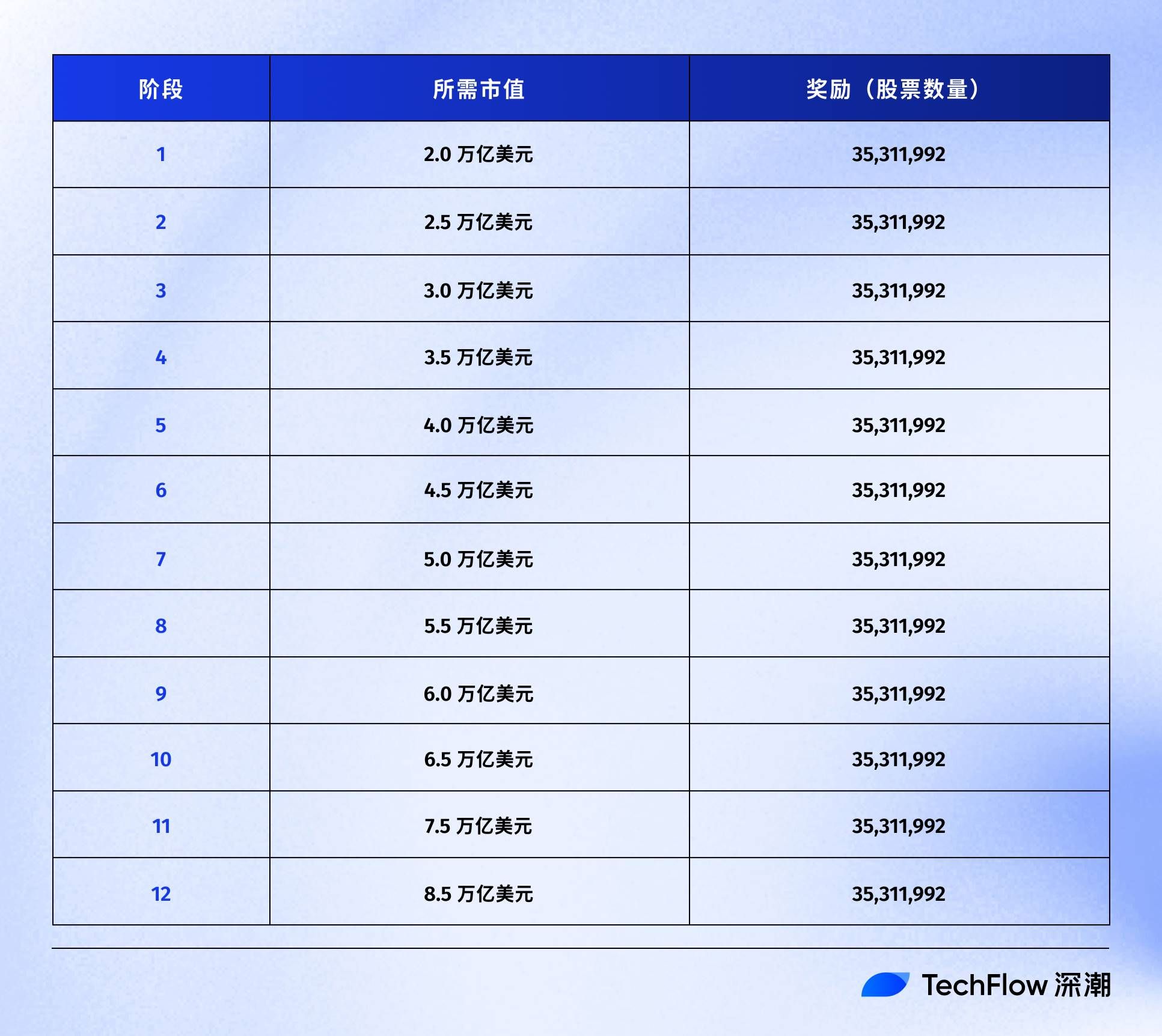Written by: Niusike, Deep Tide TechFlow
In the early morning of November 7, Tesla shareholders cast an unprecedented vote, with more than 75% approving Elon Musk’s compensation plan worth up to 1 trillion USD.
After the voting results were announced, the scene erupted in enthusiastic cheers, with Tesla shareholders loudly chanting Musk’s name.
If this compensation agreement is fully realized, Musk will leap from being the world’s richest man to becoming the world’s first “trillionaire.”
Marching Toward an 8.5 Trillion USD Market Cap
How can Musk secure a trillion-dollar compensation?
According to public documents, Musk’s incentive plan is divided into 12 stages, each with clear market cap and operational targets.
The market cap targets start at 2 trillion USD and ultimately reach 8.5 trillion USD. For each completed stage, Musk will receive about 35.31 million shares. After all stages are completed, his shareholding may increase from the current 15% to 25%.

Of course, the market cap requirement is not just a temporary spike to the target level; it must be maintained for at least six months to unlock.
In addition to market cap requirements, each stage also has corresponding business targets.
For example, the first stage requires the completion of one of the following 12 operational milestones, while the third stage requires the completion of any three of these 12 milestones.
The twelve operational milestones:
1. Adjusted EBITDA: 50 billion USD
2. Adjusted EBITDA: 80 billion USD
3. Adjusted EBITDA: 130 billion USD
4. Adjusted EBITDA: 210 billion USD
5. Adjusted EBITDA: 300 billion USD
6. Adjusted EBITDA: 400 billion USD
7. Adjusted EBITDA: 400 billion USD
8. Adjusted EBITDA: 400 billion USD
9. Cumulative vehicle deliveries: 20 million units
10. FSD users: 10 million
11. Robotaxi: 1 million taxis
12. Humanoid robots: cumulative delivery of 1 million robots
These targets must be completed within ten years, and some require being maintained for a certain period to take effect.
According to these requirements, if Tesla achieves an adjusted EBITDA (earnings before interest, taxes, depreciation, and amortization) of 130 billion USD in a single year in the coming years, and a market cap of 3 trillion USD, it can unlock rewards for stages one to three, granting a total of 105 million USD worth of stock. This is because 130 billion USD in EBITDA means the company has reached three operational milestones (adjusted EBITDA of 50 billion, 80 billion, and 130 billion USD).
Is It Achievable?
In the nine months ending September 2025, Tesla’s net profit was 2.9 billion USD, with adjusted EBITDA of 10.8 billion USD, and the adjusted EBITDA for 2025 is expected to be 14.4 billion USD.
At this level, Tesla would need to grow at a compound annual rate of 51% to reach 400 billion USD by 2033 and maintain it for another two years.
This means sales would need to jump from 93 billion USD to 2.5 trillion USD, which from a cash flow perspective is nearly insane—an almost impossible task.
But Tesla’s valuation has never been the result of a cash flow model; it is the product of “narrative leverage.” If the story is strong enough, the market will naturally provide a premium.
Narratives drive prices up, and prices in turn validate the correctness of the narrative.
Expectations and confidence in Tesla’s high valuation have always been built on “optionality”—any one of its side businesses (AI, robotics, energy) could become a new growth engine.
Therefore, the real significance of this incentive plan may not lie in the bonus amount, but in the fact that it binds Musk’s strategic direction for the next decade:
Tesla must achieve comprehensive breakthroughs in AI, energy, autonomous driving, and manufacturing to fulfill this “visionary economic experiment.”
From this perspective, the market cap target may actually be the easiest part of the plan to achieve.
The Era of Strongmen
In this vote, what Musk gained is far more than just financial incentives.
If the plan is fully realized, his shareholding will rise from 15% to about 25%, meaning a further concentration of governance power.
The capital market’s trust in Musk is almost religious.
More than 75% of shareholders chose to support this plan, even though it would dilute their own equity and weaken the board’s checks and balances, they are still willing to let Musk continue to lead Tesla’s destiny.
As a result, Tesla has moved beyond the traditional sense of a public company to become a “narrative platform” centered around its founder, with its valuation, strategy, brand, and technological pace all tied to the will of one person.
Similar phenomena are playing out in different industries—the world is entering an era of strongmen.
In the AI field, companies like OpenAI and Anthropic have equity and voting mechanisms that reinforce the long-term dominance of core founders;
In the cryptocurrency world, many protocols also revolve around the “core founder + token narrative.”
Founders provide the story and direction, capital provides resources and time, and governance rights are consciously relinquished in exchange for the continuation and expansion of the narrative.
The essence of the era of strongmen, is a form of collective voluntary relinquishment.
Investors, employees, regulators, and even society as a whole are, in the name of “growth” and “innovation,” handing more power back to a select few.
Worth Learning for Web3
Tesla’s equity incentive can also be seen as a kind of Tokenomics experiment.
In the crypto world, many projects release a large portion of tokens to the team and founders all at once after the Token Generation Event (TGE).
Narrative comes first, delivery lags behind—this has become a common structural flaw. Project teams often cash out early after telling a grand enough story, while execution, product, and profits are postponed.
This “cash out first, build later” model can attract speculative capital in the short term, but it is difficult to support long-term innovation and trust.
In contrast, Tesla’s compensation plan is more like a structured long-term incentive model.
Equity incentives are not granted at the outset, but only unlocked after the market cap reaches a certain range and is maintained for a period; moreover, rewards must be tied to specific outcomes, including revenue, profit, user or product delivery, and other quantifiable indicators; ultimately, it is up to shareholders to decide whether to approve.
If founders and teams want high returns, they must continuously drive growth in market cap, cash flow, and products.
If the crypto industry could introduce similar structures, allowing token incentives to be released in sync with market cap performance and product outcomes, it might help filter out projects that can truly generate cash flow and utility value.
Let Web3 truly move from “storytelling” to “product delivery.”
But if that happens, one wonders, how many people would still choose to start a business in Web3?



